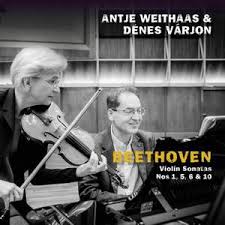BEETHOVEN Violin Sonatas 1, 5, 6, 10 (Antje Weithaas)
View record and artist detailsRecord and Artist Details
Genre:
Chamber
Label: Avi Music
Magazine Review Date: 06/2024
Media Format: CD or Download
Media Runtime: 99
Mastering:
DDD
Catalogue Number: AVI8553508

Tracks:
| Composition | Artist Credit |
|---|---|
| Sonata for Violin and Piano No. 5, 'Spring' |
Ludwig van Beethoven, Composer
Antje Weithaas, Violin Dénes Várjon, Piano |
| Sonata for Violin and Piano No. 6 |
Ludwig van Beethoven, Composer
Antje Weithaas, Violin Dénes Várjon, Piano |
| Sonata for Violin and Piano No. 1 |
Ludwig van Beethoven, Composer
Antje Weithaas, Violin Dénes Várjon, Piano |
| Sonata for Violin and Piano No. 10 |
Ludwig van Beethoven, Composer
Antje Weithaas, Violin Dénes Várjon, Piano |
Author: Rob Cowan
Between them violinist Antje Weithaas and pianist Dénes Várjon made me question the very basis of how I, as a listener and reviewer, approach Beethoven’s violin sonatas. Being a lover of strong, tonally distinctive violinists in this repertoire, reaching back as far as Adolf Busch, Jascha Heifetz, Arthur Grumiaux, Christian Ferras and a whole host of others, at best with keenly sparring piano partners (Busch and Serkin, Grumiaux and Haskil, Ferras and Barbizet, up to Frank Peter Zimmermann and Martin Helmchen), my first experience of Weithaas and Várjon (the Spring Sonata) had me entranced less by corporeal beauty than by the extraordinary way these two artists connect through the music.
Take the Spring Sonata’s second‑movement Adagio molto espressivo, the very opening, Várjon so free and limpid, Weithaas’s tone less sensual than spun silver to start with, then, by around 4'05", dipping to somewhere beneath pianissimo. This is a true Adagio that held me breathless, as did the canonic Scherzo, played with ease and humour. The finale is equally effective, Várjon’s elasticity a perfect foil for Weithaas’s caring approach to the solo line, though there’s more in the way of muscularity around the movement’s centre.
The Sixth Sonata, Op 30 No 1, harbours a trap that many violinists (even some of my favourites) fall into; I’m thinking of the gently swaying slow movement, where Adagio molto espressivo is often misinterpreted to mean adagio molto appassionato. Look at the score and much of the music is marked piano, aside from the odd sforzato or crescendo. The movement’s recapitulation (5'00") sees a return to the piano lullaby, with an embellished piano part. Purity is what you need here, and that’s what Weithaas and Várjon bring to the music (the movement’s close is a model of interpretative sensitivity). The theme-and-variations finale is fascinating in that for Var 4 the duo contrast the abruptness of the solo violin interjections with the more colourful piano-writing. Follow the fifth variation with the notes on the page and you realise just how meticulous these two players are in the way they follow Beethoven’s dynamic markings.
The second disc opens with a stern call to arms, the First Sonata’s opening Allegro con brio giving Várjon free rein before Weithaas softens the mood with her limpid playing of the more expressive second subject (1'09"). The second movement, another theme with variations, finds Várjon splitting chords to expressive effect as if he wants to coax a maximum of warmth from his partner’s singing line.
With the Tenth Sonata, Op 96, we reach the peak of Beethoven’s writing for the genre and a work that I’d say especially suits this thoughtful duo’s performing style. The opening famously features alternate trills played by violin and piano, and there’s a long repeat, which is happily observed. In fact, throughout the cycle, which is now complete, these players are very generous in their observance of repeats. More split chords signal further eloquence for the Adagio espressivo, where Weithaas’s first entry allows us access to her full tonal range, but come the brief, hotfoot Scherzo both players are all eagerness and panache. The Poco allegretto finale has at its centre novel improvisatory adagio interludes that need to be carefully integrated into the whole, which they certainly are here.
Before I agreed to review this set – which has turned out to be a privilege – I asked our Reviews Editor if I might hear the rest of the cycle, just so that I could put it in context with whatever else is available. The most relevant digital rivals include the consistently animated partnership of Frank Peter Zimmermann and Martin Helmchen, the lively and intelligent duo of Isabelle Faust and Alexander Melnikov and the sweeter-centred James Ehnes with the excellent Andrew Armstrong at the piano. Regarding the set under review, I have now listened to all three volumes. I can tell you that not a single performance falls beneath the exceptionally high interpretative standard exhibited in this most recent release. I’m not going to say I’ll abandon the violinists mentioned above (and many more) but henceforth Antje Weithaas and Dénes Várjon rank among the most stimulating interpreters of these wonderful works. If you want the physical discs, then I’d suggest you acquire this double pack first, then purchase the two remaining single discs. The drama of Sonata No 7 in C minor is in Vol 2 (1/24), while the urgent Fourth Sonata and the symphonic scale of the Kreutzer both feature in Vol 1 (7/23). Those three should be your next ports of call. So far as these sonatas are concerned, Weithaas and Várjon allow you to learn, listen and love as never before.
Discover the world's largest classical music catalogue with Presto Music.

Gramophone Digital Club
- Digital Edition
- Digital Archive
- Reviews Database
- Full website access
From £8.75 / month
Subscribe
Gramophone Full Club
- Print Edition
- Digital Edition
- Digital Archive
- Reviews Database
- Full website access
From £11.00 / month
Subscribe
If you are a library, university or other organisation that would be interested in an institutional subscription to Gramophone please click here for further information.




